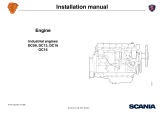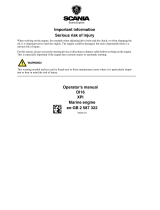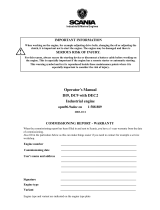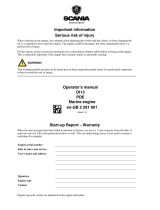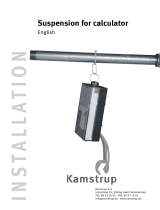Page is loading ...

INSTALLATION
MANUAL
©
Scania CV AB 2015, Sweden
02:01 Issue 6.0 en-GB 1
Engine
Marine engines
DI09, DI13, DI16

INSTALLATION
MANUAL
©
Scania CV AB 2015, Sweden
02:01 Issue 6.0 en-GB 2
Engine suspension....................................................................................................3
Design requirements............................................................................................ 3
Flexible engine suspension.................................................................................. 4
Rigid engine suspension...................................................................................... 6
Suspension of reverse gear.................................................................................. 7
Permissible installation and operating angles ..................................................... 8
Flywheel housings............................................................................................... 9
Lifting the engine .............................................................................................. 10
Engine bed......................................................................................................... 10
Accessibility for maintenance and repairs ..........................................................11
Installation requirements ................................................................................... 11
Clearances ......................................................................................................... 13
Engine alignment................................................................................................... 14
Flexible coupling............................................................................................... 15
Aligning engine and shafts................................................................................ 16
Power transmission ...............................................................................................21
Flexible coupling............................................................................................... 21
Friction clutch ................................................................................................... 22
Transmission types ................................................................................................23
Mechanical transmissions ................................................................................. 23
Belt transmissions ............................................................................................. 23
Power take-offs ......................................................................................................25
Front-mounted power take-offs......................................................................... 25
Side-mounted power take-offs .......................................................................... 27
Connection of sensors for external monitoring systems ....................................34
DI09 and DI13................................................................................................... 35
DI16................................................................................................................... 37
Torsional oscillations ............................................................................................ 39
Data for torsional oscillation calculation.......................................................... 39
Torsional oscillation calculations from Scania................................................. 40
General tightening torques for screw joints ....................................................... 42
Specification of normal tightening torques....................................................... 42
Tightening torques ............................................................................................ 43

INSTALLATION
MANUAL
©
Scania CV AB 2015, Sweden
Engine suspension
02:01 Issue 6.0 en-GB 3
Engine suspension
Design requirements
The type of engine suspension that is appropriate varies for different engine installa-
tions. In general, the following applies:
• The engine suspension should be designed for the forces it is exposed to, both
continuously and momentarily during operation. Such forces are reaction forces
from the transmitted torque and in some cases longitudinal acceleration, retarda-
tion and reaction forces in the engine.
• For engines with marine transmission, Scania recommends a 6-point suspension
or common rear suspension for pipes, transmission and engine.
• Both the engine suspension and the engine bed should be designed so that there
are no resonant oscillations within the engine speed range. They should also be
designed so that annoying vibrations from the engine are not transmitted to the
surroundings.
• The engine suspension and engine bed should be designed in a manner which al-
lows access for maintenance and repair work.
• The engine bed location and the engine suspension must be designed so that the
permissible angles of inclination for the engine are not exceeded. See the table
Permissible installation and operating angles.
IMPORTANT!
If the angles of inclination are exceeded, lubrication system performance will deteri-
orate, which can cause damage to the engine or reduce its service life.
There are two standard engine suspension designs:
• flexible engine suspension
• rigid engine suspension.

INSTALLATION
MANUAL
©
Scania CV AB 2015, Sweden
Engine suspension
02:01 Issue 6.0 en-GB 4
Flexible engine suspension
Flexible engine suspension dampens vibrations more effectively than rigid engine
suspension. It prevents extreme movement between engine and engine bed during vi-
olent ship movement. Flexible engine suspension can also absorb some level of re-
action force from the propeller. Flexible engine suspension does not require such
careful alignment of the engine as rigid engine suspension.
However, flexible engine suspension does not absorb longitudinal and lateral forces
in the engine to the same extent as rigid engine suspension.
327 968
Examples of flexible engine suspension

INSTALLATION
MANUAL
©
Scania CV AB 2015, Sweden
Engine suspension
02:01 Issue 6.0 en-GB 5
Insulators
Cushyfloat insulators with hardness 55 or 65 Shore can be ordered as option.
The engine bracket and frame or engine bed should be
parallel.
Vertical centre lines should coincide laterally. Upper and lower parts of the insulators should be par-
allel longitudinally.
310 404
160±10 Nm
Tightening torque
310 405
55
55
alt. 65
Hardness marking
310 407
max 1°
310 408
0°
310 406
0°
55

INSTALLATION
MANUAL
©
Scania CV AB 2015, Sweden
Engine suspension
02:01 Issue 6.0 en-GB 6
Rigid engine suspension
A rigid engine suspension can absorb greater forces in all directions than flexible en-
gine suspension. It requires highly accurate alignment of the engine in relation to the
driven unit. On the other hand, it requires no special flexibility in the hoses, pipes and
controls connected to the engine.
A rigid engine suspension can be used in engine installations where vibration causes
no significant problems and where other characteristics make it desirable.
Even with a rigid engine suspension, the transmission of vibration to the engine bed
can be kept low if the masses of the engine bed and connected parts are large in re-
lation to the mass of the engine.
It is also possible to construct flexible engine suspension between the frame and the
engine bed to reduce the transmission of vibration to the engine bed.
327 967
Examples of rigid engine suspension
328 053
Example of rigid engine suspension for single-speed engines

INSTALLATION
MANUAL
©
Scania CV AB 2015, Sweden
Engine suspension
02:01 Issue 6.0 en-GB 7
Suspension of reverse gear
Built-on reverse gear can either have separate brackets or suspension attachments
which are integrated with the engine.
Contact Scania or the supplier of the reverse gear about approved type of suspension
for reverse gear.
327 753
Example of suspension of a reverse gear

INSTALLATION
MANUAL
©
Scania CV AB 2015, Sweden
Engine suspension
02:01 Issue 6.0 en-GB 8
Permissible installation and operating angles
Maximum permissible installation angle means maximum permissible installation
angle for an engine relative to the horizontal plane. The angle indicates the limit for
engine inclination during continuous operation.
Maximum operating angle means maximum permissible angle of inclination for an
engine in operation and with minimum oil level. The angle may only be used for
short periods. The maximum forward or rearward operating angles are not applicable
to their full extent if the engine is inclined laterally at the same time.
Engine type Type of oil sump Max. installation angle Max. operating angle Oil capacity (litres)
Inclination rear-
wards and for-
wards
Inclination lat-
erally
Inclination rear-
wards and for-
wards
Inclination lat-
erally
Min. Max.
DI09 Standard oil sump 12° 12° 30° 30° 32 38
DI09 Low oil sump 12° 12° 20° 30° 25 32
DI13 Standard oil sump with ladder frame 12° 12° 30° 30° 39 45
DI13 Standard oil sump without ladder frame 12° 12° 30° 30° 36 30
DI13 Low oil sump 12° 12° 25° 30° 28 34
DI13 Extra low oil sump 12° 12° 25° 30° 25 30
DI16 Standard oil sump 12° 10° 25° 30° 40 48
DI16 Low oil sump 12° 10° 25° 30° 29 37

INSTALLATION
MANUAL
©
Scania CV AB 2015, Sweden
Engine suspension
02:01 Issue 6.0 en-GB 9
Flywheel housings
Silumin housings are supplied as standard on most marine engines, except on certain
16 litre engines. The maximum permissible bending torque for a silumin housing is
10,000 Nm. This presumes that there are no axial loads from, for example, the pro-
peller shaft, abnormal G forces or vibration.
However, nodular iron flywheel housing can also be chosen. Nodular iron housings
can dampen vibrations at certain engine speeds but increase vibrations at other en-
gine speeds. Nodular iron is stronger than silumin and can therefore tolerate greater
bending and torsional forces. Certain 16 litre engines have nodular iron casing as
standard.
The stronger nodular iron housings are recommended in installations where the fly-
wheel housing is exposed to serious stress, e.g. with high reverse gear ratios and
when heavy components without support are attached to the rear of the engine (e.g.
hydraulic pump). Nodular iron housings are also recommended for generator sets
with high outputs.
The propeller installation without separate thrust bearing can be approved if the fol-
lowing requirements are met:
• Max. pressure load from the propeller must not exceed 40,000 N.
• Reverse gear ratio must not exceed 2:1.
• The suspension must be on the front engine bracket and the common bracket for
the rear edge of the engine and the reverse gear.
• The displacement between the input and output shaft of the reverse gear must not
exceed 250 mm.
• Most of the propeller force must be taken up by the rear suspension.
• The support points of the brackets must be aligned with the propeller shaft as
much as possible.

INSTALLATION
MANUAL
©
Scania CV AB 2015, Sweden
Engine suspension
02:01 Issue 6.0 en-GB 10
Note:
The suspension must be dimensioned for the appropriate pressure load.
For the installation to be approved in a propeller installation with a reverse gear ratio
greater than 2:1, the pressure forces must be fully taken up in the reverse gear sus-
pension.
Contact Scania if it is difficult to determine the size and type of load.
Lifting the engine
WARNING!
The engine lifting eyes are dimensioned for lifting the engine only, not the engine to-
gether with connected equipment or frame!
Engine bed
The engine bed should be made as robust and rigid as possible. The attachment to the
hull should be as widely distributed as possible.
The engine bed should have welded support plates for engine and reverse gear. The
brackets should be as low as possible. Accessibility underneath the engine must be
good so that the oil sump can be removed for example.
There must be space for spacers with a thickness of 5-10 mm between the engine
brackets and the engine bed brackets for accurate alignment.

INSTALLATION
MANUAL
©
Scania CV AB 2015, Sweden
Accessibility for maintenance and repairs
02:01 Issue 6.0 en-GB 11
Accessibility for maintenance and repairs
Installation requirements
The installer is responsible for ensuring that accessibility is ensured for maintenance
and repairs.
Note:
There must be sufficient space at installation so that standard times for maintenance
and repairs can be attained.
The following requirements for accessibility must be met:
• Canopies and connected components must be designed so that the engine can be
removed and fitted without time being lost due to obstructive structures.
• In the case of static engine installations, there should be permanent securing
points for lifting devices above the unit.
• The fuel system must be easily accessible for maintenance and bleeding.
• It should be possible to read the graduations on the flywheel when adjusting
valves and unit injectors.
• It should be possible to remove and fit the cylinder head, rocker covers and push-
rods while leaving the engine in place.
• It must be possible to remove the oil sump in order to renew cylinder liners or pis-
tons with the engine in place.
• It should be easy to fill and drain oil. In addition, the oil dipstick must be easily
accessible.
• Centrifugal oil cleaners and oil filters must be easy to access for maintenance and
renewal.
• It should be easy to fill and drain coolant.
• Engine air filters must be located so that they are easy to access for the renewal
of filter elements.

INSTALLATION
MANUAL
©
Scania CV AB 2015, Sweden
Accessibility for maintenance and repairs
02:01 Issue 6.0 en-GB 12
It must also be easy to carry out maintenance on the following components:
• Turbocharger
• Starter motor
• Generator
• Coolant pump
• Seawater pump and seawater filter
• Heat exchanger
• Sacrificial anodes
• Clutch
• Batteries

INSTALLATION
MANUAL
©
Scania CV AB 2015, Sweden
Accessibility for maintenance and repairs
02:01 Issue 6.0 en-GB 13
Clearances
The most important clearances are shown in the table and illustrations below. The
specified measurements apply to the largest standard equipment.
Measurement Clearance (mm) For maintenance or renewal of
DI09, DI13 DI16
A 150 900 Cylinder liner, cylinder head etc.
B 250 300 Oil sump
F 400 400 Various units
L 150 150 Seawater pump impeller
Clearances for DI09 and DI13 Clearances for DI16

INSTALLATION
MANUAL
©
Scania CV AB 2015, Sweden
Engine alignment
02:01 Issue 6.0 en-GB 14
Engine alignment
The alignment of the engine in relation to the driven unit is very important in order
to prevent malfunctions.
Otherwise there is a risk of vibration and serious stress to the crankshaft, engine
brackets, drive shaft and coupling, causing damage which is costly to repair.
For propeller installations, a first alignment is made before the ship is launched.
Alignment must then be checked after the ship is launched and has been placed under
load. The ship should also be laden and equipped with filled tanks.
Since there can be some settling in the hull after the first hours of operation, further
checks on the alignment should be made after a period in service.
Alignment should be checked regularly on certain vibration-sensitive engine instal-
lations.
If flexible engine suspension is part of the system, this should be placed under load
before alignment. Otherwise, it will quickly settle by several millimeters.
Poor alignment between engine and propeller shaft can cause damaging vibration in
the hull, damage to the reverse gear and accelerated wear of the shaft and propeller
bearings.

INSTALLATION
MANUAL
©
Scania CV AB 2015, Sweden
Engine alignment
02:01 Issue 6.0 en-GB 15
Flexible coupling
The alignment requirements are reduced if a flexible coupling is installed between
the engine and the driven unit. Refer to the data on the flexible coupling concerned
for permissible deviations.
Flexible coupling allows a certain angular displacement towards the output shaft. It
also has an effect of evening out irregularities in torque and therefore counteracts the
tendency towards torsional oscillation. The correct choice of rubber hardness reduces
the stress on the driven units.
Relatively large deviations are permissible with flexible couplings. However, align-
ment should be as accurate as possible to achieve low vibration and a long service
life on the coupling.

INSTALLATION
MANUAL
©
Scania CV AB 2015, Sweden
Engine alignment
02:01 Issue 6.0 en-GB 16
Aligning engine and shafts
Start from the driven shaft when aligning. First check that this is straight. Alignment
is made easier if the engine brackets are equipped with adjusting screws for vertical
and lateral adjustment. However, permanent setting should be made using shims.
Adjust the engine alignment vertically using shims between the engine bed and en-
gine suspension and laterally by moving the engine sideways on the surface. Shafts
with flanges: Start by aligning roughly and secure the engine to its engine bed. Mate
the flanges (1) so that the guide edge of one flange enters the guide hole of the other
flange.
Calculation of angular deviation
1. Fit the stand for the dial gauge (2) to the driving flange.
2. Align the tip of the dial gauge with the axial surface of the other flange as far as
possible.
3. Zero the dial gauge at 12 o'clock.
4. Place one of the retaining screws through both flanges without tightening it.
5. Turn the shafts at the same time and read the dial gauge at intervals of 90° while
turning one revolution. Enter the values in the table. Make sure you use the right
signs.
6. Calculate the angular deviation between the shafts using the values.
Location of measure-
ment point
Measurement value
1
1. + means inwards and - means outwards
12 o'clock ±0 mm
3 o'clock ± mm
6 o'clock ± mm
9 o'clock ± mm
2
1
344 283
Measuring the angular deviation

INSTALLATION
MANUAL
©
Scania CV AB 2015, Sweden
Engine alignment
02:01 Issue 6.0 en-GB 17
Calculating thickness of required shims
Note:
Make sure you use the right signs in the calculations.
t = thickness of required shims.
L = distance between engine suspensions.
D = diameter of the flange where the dial gauge is mounted.
• If t is positive, shims should be added to the front or removed from the rear.
• If t is negative, shims should be added to the rear or removed from the front.
t =
6
o'clockx
L
D

INSTALLATION
MANUAL
©
Scania CV AB 2015, Sweden
Engine alignment
02:01 Issue 6.0 en-GB 18
Calculating lateral adjustment
Note:
Make sure you use the right signs in the calculations.
s = lateral displacement of engine suspension.
L = distance between engine suspensions.
D = diameter of the flange where the dial gauge is mounted.
• If s is positive, the front engine suspension must be moved to the right.
• If s is negative, the front engine suspension must be moved to the left.
Checking parallelism of the flanges with a feeler gauge
Angular deviation between the shaft centrelines can also be checked using a 0.1 mm
feeler gauge. Do this by measuring the distance between the surfaces of the flanges
at the outer edges.
During measurement, the engine must be tightened onto the engine bed.
s =
(3 o'clock - 9
o'clock) x L
D
344 284

INSTALLATION
MANUAL
©
Scania CV AB 2015, Sweden
Engine alignment
02:01 Issue 6.0 en-GB 19
Measuring parallel displacement
1. Move the tip of the dial gauge to the radial surface of the flange. Pull apart the
flanges (1) so that the guide edge is released as depicted in the figure to the right.
2. Zero the dial gauge (2) at 12 o'clock.
3. Lift or press down the driven shaft as far as the radial clearance will allow. Read
the dial gauge and enter the reading with the correct sign on the radial clearance
line.
If the driven shaft is very long, there must also be compensation for bending of
the shaft from its own weight. This can be obtained by lifting the end of the shaft
using a spring balance, which then shows the weight of the flange and half the
free part of the shaft. Deflection can then be calculated using this weight.
The same must also be done if the drive shaft is long or has some play.
4. Reset the dial gauge again. Place one of the retaining screws through both flanges
without tightening it.
5. Turn the shafts at the same time, read the dial gauge at intervals of 90° while turn-
ing one revolution and enter the values in the table. Make sure you use the right
signs.
6. Calculate the parallel displacement between the shafts using these values.
Location of measure-
ment point
Measurement value
1
1. + means inwards and - means outwards
12 o'clock ±0 mm
3 o'clock ± mm
6 o'clock ± mm
9 o'clock ± mm
Radial clearance
2
2. + means lift and - means press
±mm
2
1
344 287
Measuring centring

INSTALLATION
MANUAL
©
Scania CV AB 2015, Sweden
Engine alignment
02:01 Issue 6.0 en-GB 20
Calculating parallel displacement
Note:
Make sure you use the right signs.
Shafts without flange
If both shaft ends are free during alignment, alignment can be checked using a dial
gauge (2) set up as depicted in the figure. Readings should be taken with the tip of
the dial gauge in two different places at least 200 mm apart axially. Turn the shafts
at the same time and read the results on the dial gauge.
Permissible deviations
After taking measurements, a final check should be made. All screws, except those
for the flange joint, should be tightened to the torque specified by the manufacturer.
Upon measurement, deviation should not exceed 0.1 mm.
The requirements for the accuracy of the alignment can vary depending on the design
of the engine installation. If the requirements for accuracy are lower, the permissible
deviation may be greater than indicated above.
Vertical
t =
6 o'clock +
clearance
2
Lateral
t =
3 o'clock +
9 o'clock
2
2
344 288
Measuring with free shaft ends
/
